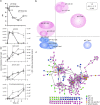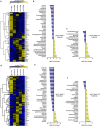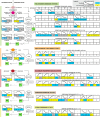Meta-omics uncover temporal regulation of pathways across oral microbiome genera during in vitro sugar metabolism
- PMID: 26023872
- PMCID: PMC4817640
- DOI: 10.1038/ismej.2015.72
Meta-omics uncover temporal regulation of pathways across oral microbiome genera during in vitro sugar metabolism
Abstract
Dental caries, one of the most globally widespread infectious diseases, is intimately linked to pH dynamics. In supragingival plaque, after the addition of a carbohydrate source, bacterial metabolism decreases the pH which then subsequently recovers. Molecular mechanisms supporting this important homeostasis are poorly characterized in part due to the fact that there are hundreds of active species in dental plaque. Only a few mechanisms (for example, lactate fermentation, the arginine deiminase system) have been identified and studied in detail. Here, we conducted what is to our knowledge, the first full transcriptome and metabolome analysis of a diverse oral plaque community by using a functionally and taxonomically robust in vitro model system greater than 100 species. Differential gene expression analyses from the complete transcriptome of 14 key community members revealed highly varied regulation of both known and previously unassociated pH-neutralizing pathways as a response to the pH drop. Unique expression and metabolite signatures from 400 detected metabolites were found for each stage along the pH curve suggesting it may be possible to define healthy and diseased states of activity. Importantly, for the maintenance of healthy plaque pH, gene transcription activity of known and previously unrecognized pH-neutralizing pathways was associated with the genera Lactobacillus, Veillonella and Streptococcus during the pH recovery phase. Our in vitro study provides a baseline for defining healthy and disease-like states and highlights the power of moving beyond single and dual species applications to capture key players and their orchestrated metabolic activities within a complex human oral microbiome model.
Conflict of interest statement
The authors declare that Dr W Shi is a part time Chief Science Officer of C3 Jian Inc., which has licensed technologies from UC Regents that could be indirectly related to this research project. The other authors declare no conflict of interest.
Figures




References
-
- Alaluusua S, Kleemola-Kujala E, Nystrom M, Evalahti M, Gronroos L. (1987). Caries in the primary teeth and salivary Streptococcus mutans and lactobacillus levels as indicators of caries in permanent teeth. Pediatr Dent 9: 126–130. - PubMed
-
- Andrade SL, Einsle O. (2007). The Amt/Mep/Rh family of ammonium transport proteins. Mol Membr Biol 24: 357–365. - PubMed
-
- Arneberg P, Giertsen E, Emberland H, Ogaard B. (1997). Intra-oral variations in total plaque fluoride related to plaque pH. A study in orthodontic patients. Caries Res 31: 451–456. - PubMed
Publication types
MeSH terms
Associated data
Grants and funding
LinkOut - more resources
Full Text Sources
Other Literature Sources
Molecular Biology Databases

